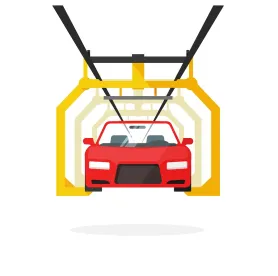The Center for Automotive Research (CAR)’s annual Management Briefing Seminars are being held this week in Traverse City, Michigan. Tuesday’s sessions included an annual highlight of the conference: a detailed update and outlook on “Forecasting the North American Sales and Production Footprint in Uncertain Times,” presented by a panel of leading automotive forecasters, analysts and economists. Unlike the more rosy tone from last year when I reported that “The Sky Is Not Falling,” this year’s themes could be summed up as: “Risk, Disruption and Declining Peak.” Most of the forecasts included only a modest decline (by historical standards) from sales of 17.2 million units in 2017 to somewhere in the mid-high 16 million units by 2020, but when combined with current trade and regulatory uncertainties the overall tone of the panel was more cautious this year. The other glaring theme from the panel, not only in North America but in many other world markets, was the continuing route of SUVs and CUVs over sedans, with a market share that is only expected to increase.
The panelists for the session included moderator Bernard Swiecki, Director – Automotive Communities Partnership (ACP) and Senior Automotive Analyst, CAR; Michael Robinet, Managing Director, Automotive Advisory Services, IHS Markit; Rebecca Lindland, Senior Director, Executive Analyst, Kelley Blue Book; Mike Jackson, Executive Director, Strategy and Research, the Original Equipment Suppliers Association (OESA); and Joseph McCabe, President & CEO, AutoForecast Solutions LLC.
Michael Robinet of IHS themed his presentation “Mitigating Expanding Risk and Finding Stability Amid Shifting Trade, Regulatory, Cost and Market Risks.” Mike began with a summary of the current headline risk – trade and tariffs – and noted that if Section 232 tariffs were imposed on all auto parts and light vehicles the projected cost of the average U.S. vehicle would increase by about $1,800 (and a higher $5,800 for imported premium brands). This would result in a possible loss of sales of 1.4 – 2 million vehicles on an annualized basis in North America (with total sales of 14-15 million units in that scenario), with Canada being hit the hardest. He described the current sales trends in North America as a “declining plateau,” with projected North American light vehicle sales of 17.0 million in 2018, 16.8 million in 2019 and 16.6 million in 2020. Over the same period, he projects North America light vehicle output to be 17.2 million units in 2018, 17.4 million in 2019 and 17.4 million in 2020. Mr. Robinet noted that some of the additional capacity coming on line in North America over the forecast period will result in some import substitution away from principally domestic OEMs. By 2021 he forecasts a 4 million unit annual production gap between SUVs/CUVs and sedans, as more SUV/CUV launches hit the market over the forecast horizon. In the autonomous vehicle space, Mr. Robinet emphasized that the near-term focus will be on Level 2 and Level 3 autonomy, with autonomous features being a true market differentiator for those who get it right and a projected rise of sales to 6 million autonomous units (principally Level 2 and 3) by 2023. He sees growth of Level 4 and 5 autonomy coming by 2030 and beyond, once certain regulatory, societal and technical challenges are overcome. Mr. Robinet emphasized how critical it is for suppliers to be proactive, in terms of their opportunity targeting, technology road mapping, production/development support footprint, competitive analysis and financial outlook. Finally, he noted the many disruptions that must be navigated, amid the unprecedented change the market will face over the next decade.
Joe McCabe of AutoForecast Solutions also focused his presentation on the many disruptions facing the automotive industry. In spite of these headwinds, he offered a bit more optimistic view of North American production over the forecast period, with 17.54 million units in 2018, 17.85 million in 2019 and 18.00 million in 2020. He went on to describe a market phenomenon that he dubbed “NAFTA+” or an “imperative for globalization” that will compel many OEMS to manufacture platforms not only in NAFTA but in at least one other country. This phenomenon will result in 43% of vehicles sold to be NAFTA+ by 2025, with a result that OEMs will be adding new competitors into their mix as the produce products in other geographies. He further noted the continuing loss of market share by cars vs. SUVs/CUVs, on a global basis.
Rebecca Lindland of Kelly Blue Book noted, based on a recent survey, the potential consumer reactions to tariff increases, with 30% responding that they may switch the type of vehicle they are interested in, 18% may switch from shopping from a new to a used car, 12% may shift from shopping imported to domestic models, 15% may delay their purchase and only 7% said they would simply pay more. She noted the potential impacts of tariffs on different OEMs, with brands like Chrysler having very little import share being hit the least and brands and 19 brands which have 100% import share being hit the hardest. Ms. Lindland’s projection of North American sales was 17.0 million units in 2018, 16.8 million in 2019 and 16.7 million in 2020. She noted that year to date sedan sales in North America are 12% lower vs. 2017, after falling 10.8% in 2017.
Mike Jackson of OESA offered a similar forecast of North American light vehicle sales, noting a downward trend to 16.7 million units in 2020 off the 2017 rate of 17.2 million units, which he noted to be a relatively small percentage drop. Mr. Jackson reviewed OESA’s most recent supplier sentiment poll, which experienced a staggering 10-point drop from 53 (50 being neutral) in Q2 2018 to 43 in Q3 2018, based largely on concerns over tariffs. He then went on to address the million dollar question in the supplier sentiment survey: when is the next U.S. recession going to occur? Based on the supplier survey, 58.8% named 2020 with 21.6% responding 2021 and 7.8% responding 2019 or 2022. If 2020 is an accurate prediction, that would culminate an unprecedented 9+ years of automotive market expansion, the longest in the last 50 years. Triggers for what could produce that recession are less clear, although trade policy is forefront in the minds of many at this point.
As usual, we live in interesting times in the automotive industry. Successful suppliers will be those that can effectively assess and address the many risks and uncertainties which they will face in 2018 and beyond.




 />i
/>i

